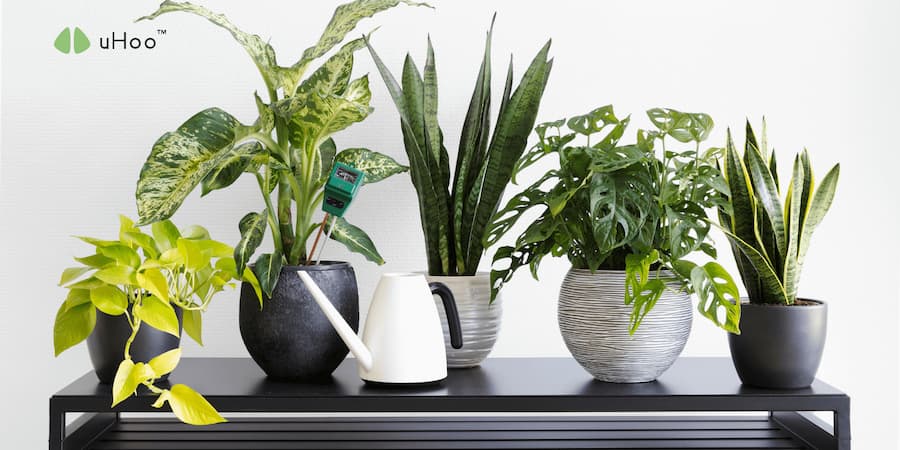Indoor plants were first appreciated for their aesthetic purpose, but they serve a bigger purpose besides beautifying your living or working space.
NASA scientists were curious about the role of common houseplants in enhancing indoor air quality as part of their research for future space station environments. They conducted experiments to evaluate how these plants influenced indoor air pollutants. The results indicated that houseplants can remove certain pollutants, with specific plants being more effective at targeting particular contaminants.
This blog post will discuss which house plants are best for maintaining the best indoor air quality.
12 Must-Have Indoor Plants for a Healthier Space
Spider plant – Chlorophytum comosum ‘Vittatum’
The spider plant can remove formaldehyde from the air. Common formaldehyde emitters include cigarette smoke, nail polish, and synthetic carpeting. They are easy to care for and thrive best in semi-shaded places. It is also recommended to let them dry out after watering because they dislike soggy soil.
English Ivy – Hedera helix
One popular choice for indoor plants is English Ivy. It can remove the most common indoor pollutants, like benzene, and grows well in low light and cool temperatures. A highly recommended practice is to spray the English ivy leaves weekly to keep them moist and ward off spider mites.
Bamboo Palm – Chamaedorea seifrizii
The bamboo palm, also known as the reed palm, is well-known for effectively removing benzene, trichloroethylene, and formaldehyde from the air. Due to its height, which can reach up to 12 feet, bamboo palms can purify more contaminants from the air. Bamboo palms need an abundant amount of sunlight to grow well, so it is best to position them near windows or doors.
Gerbera Daisy – Gerbera jamesonii
Aside from being colorful flowers, the Gerbera daisy is excellent at removing benzene and trichloroethylene from indoor air. These flowers need plenty of sunlight and well-drained soil to thrive. They also require regular watering, but be cautious not to overwater them, as they are susceptible to root rot.
Peace Lily – Spathiphyllum
The Peace lily is known for its ability to remove mold spores, formaldehyde, and benzene. It is also one of the few plants that can bloom indoors under low light conditions. Peace lilies prefer shaded areas and need regular watering but can tolerate occasional drought.
Snake Plant – Sansevieria trifasciata
The snake plant, also known as mother-in-law’s tongue, is a hardy plant that can remove toxins such as formaldehyde, xylene, toluene, and nitrogen oxides. It thrives in low light and requires minimal watering, making it an ideal choice for busy individuals.
Aloe Vera – Aloe barbadensis miller
Aloe Vera is not only known for its healing properties but also for its ability to remove formaldehyde and benzene from the air. It prefers bright, indirect sunlight and requires well-drained soil. Aloe Vera should be watered deeply but infrequently.
Chrysanthemum – Chrysanthemum morifolium
Chrysanthemums effectively filter out benzene, formaldehyde, and ammonia. They thrive in bright light and must be kept moist but not soggy. These plants are great for adding color and improving air quality in your home.
Boston Fern – Nephrolepis exaltata
The Boston fern is excellent at removing formaldehyde and xylene. It prefers indirect light and high humidity. Keeping the soil moist and regularly misting the leaves will help the plant thrive.
Dracaena – Dracaena marginata
Dracaena plants can filter out benzene, formaldehyde, trichloroethylene, and xylene. They prefer bright, indirect light and well-drained soil. Dracaenas need to be watered regularly but should not be overwatered.
Rubber Plant – Ficus elastica
The rubber plant effectively removes formaldehyde from the air. It thrives in bright, indirect light and needs to be watered when the top inch of soil is dry. The plant also benefits from occasional wiping of its leaves to remove dust.
Golden Pothos – Epipremnum aureum
Golden Pothos is a resilient plant known for removing formaldehyde, xylene, and benzene. It thrives in low light conditions and prefers its soil to dry out between waterings, making it an excellent plant for beginners.
Conclusion
Indoor plants offer more than just aesthetic benefits; they are crucial in purifying the air in our homes and workplaces. From NASA’s groundbreaking research to everyday observations, it’s clear that these green companions help reduce indoor air pollutants, creating healthier living environments.
Incorporating plants like the Spider Plant, English Ivy, Bamboo Palm, and Peace Lily can significantly improve air quality by targeting specific contaminants. Embrace the natural air filters and enjoy a fresher, cleaner, and more vibrant home.



